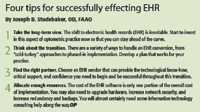Is the move toward electronic health records inevitable?
The call for electronic recordskeeping has become more insistent.

Key Points

In early 2009, the federal government passed the Health Information Technology for Economic and Clinical Health (HITECH) Act, which offers incentive payments of up to $44,000 per provider for converting to EHR. The first payments under this act will be made in 2011 to Medicare providers who are using EHR systems in a meaningful way in 2010. But after the carrot comes the stick: Beginning in 2015, Medicare payments to practitioners who are not using EHR will actually be reduced.
The increasing sophistication of diagnostic technology is also driving the trend toward EHR. For example, in the past when I ordered optical coherence tomography (OCT), my old system provided a single image. Now, I use proprietary spectral-domain optical coherence tomography technology, which generates 128 cross-sections of the eye at each exam. Grappling with the sheer volume of data from this and other devices is challenging in any format. But, I would rather integrate these digital images into an electronic system than continue to devote more office space for files of paper printouts.
Phasing in EHR
Although the conversion to EHR is not easy, I consider the time and effort to be a critical long-term investment in the practice. I would caution against setting any artificial time limits for converting to EHR. For our practice, a phased-in implementation has worked best, allowing us to realize some efficiencies quickly while gradually weaning ourselves from handwritten records.

One thing to consider at this early stage: How do you want to use EHR in the exam room? Some doctors prefer touch-screen tablets they can hold like a paper chart, while others have an employee serve as a scribe at a computer. I have a computer connected to a wall-mounted display so that the patient can see everything I enter and the same diagnostic images I'm looking at. This method requires a degree of comfort with transparency, but I consider it an asset in patient communication.
After routine exams, we began to tackle more sophisticated presentations and complex cases, such as patients with age-related macular degeneration who also have complicated systemic histories. We need to test these patients often and follow them over time.
We also added the electronic prescribing application (E-Rx, Compulink), which is one of the best things about EHR. I now e-prescribe for nearly all my patients, except those who use mail-order pharmacies or whose insurance companies don't accept e-prescriptions, or when I prescribe oral narcotics. Patients are extremely impressed that I can send a prescription directly to the pharmacy.
The electronic prescribing module makes it easy for me to participate in Medicare's E-Prescribing Incentive Program because the software supplies the relevant codes to the Centers for Medicare and Medicaid Services (CMS) with each e-prescription. The HITECH Act will require electronic prescribing to collect payments, and CMS has already indicated that it will be a factor in determining future compensation.
Where we are
Currently, we are working on fully integrating all the imaging and diagnostic technology in the office. This includes our automated refractometers, keratometers, corneal topographers, and perimeter; spectral-domain OCT; and confocal scanning laser ophthalmoscopy.
We are also customizing the software screens and drop-down menus to fit our patient flow and clinical emphases better. This is one area in which I wish we had focused more attention earlier on, because it would have helped us to be more efficient faster.
Customization can be as simple as moving a box from the left side of the screen to the right to match the order of your typical patient work-up better. Or, it can be as complex as deciding which diagnoses and treatment plans to include as default options. Regardless, any changes should be acceptable to all the practitioners using the EHR system, not just the one most active in implementing it.